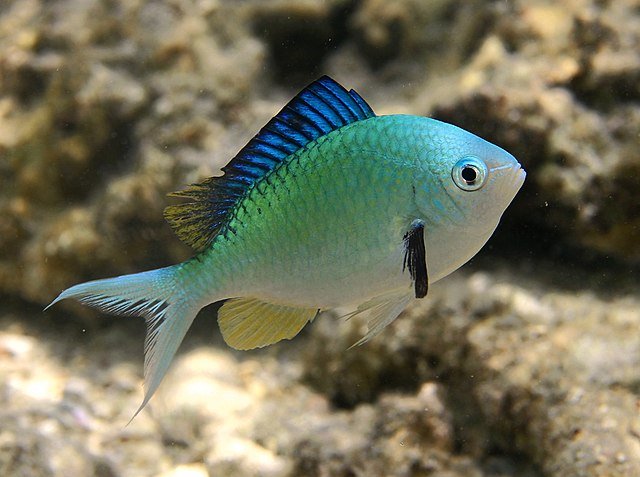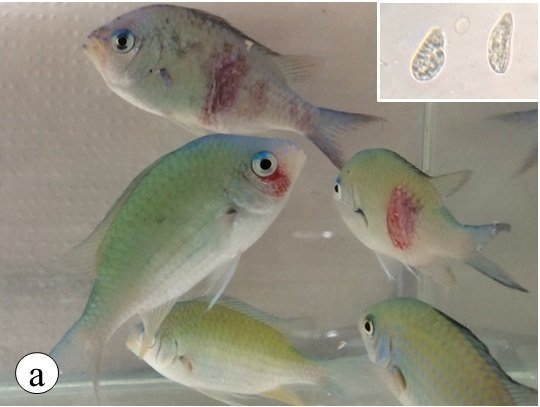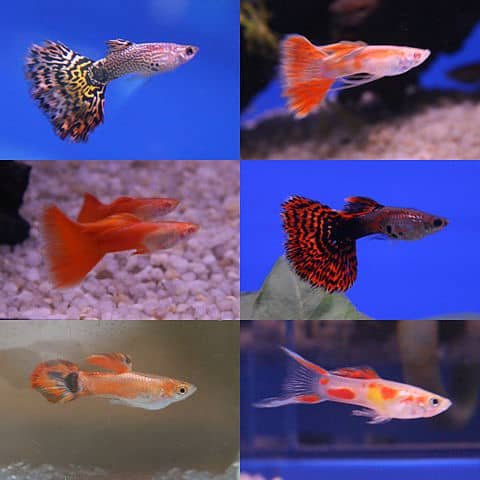
The Blue-Green Damselfish (Chromis viridis), also known as the Green Reef Chromis, is a vibrant and captivating fish native to the Indo-Pacific region. These small schooling fish are famous for their striking coloration, with males displaying a vibrant blue-green body and females adorned with a more subdued olive tone. Blue-Green Chromis are popular additions to marine aquariums due to their relatively easy care requirements and captivating behavior, making them one of the most imported marine fish to the European Union and the United States.
This article will detail everything you need to know about caring for this fish, including its habitat, diet, breeding, and the diseases that affect the Green Chromis. If you’re considering adding one of these beautiful fish to your aquarium, read on to learn how to provide the best possible care.
Characteristics of the Blue-Green Damselfish
Taxonomy
- Domain: Eukaryota
- Kingdom: Animalia
- Phylum: Chordata
- Class: Actinopterygii
- Family: Pomacentridae
- Genus: Chromis
- Species: Chromis viridis, Cuvier, 1830
- Common names: Blue-Green Chromis, Green Chromis, Blue-Green Damselfish, Blue-Green Puller
- English names: Blue-Green Chromis, Green Chromis, Blue-Green Damselfish, Blue-Green Puller
Description and Natural Habitat
The Chromis viridis is a fish from the Pomacentridae family, known for its bright blue-green color. These fish are native to the coral reefs of the Indo-Pacific, from the Red Sea to the Tuamotu Islands. They prefer clear, shallow waters (1.5 to 12 m), where they gather in large schools near branching corals.
Ben-Tzvi et al. (2008) studied the settlement and recruitment patterns of Chromis viridis over three consecutive seasons along the reefs of Eilat, Red Sea, and found a strong and repeatable preference for certain colonies of the branching coral Acropora eurystoma.
Physical Characteristics of Green Chrome
Adults reach a size of 8 to 10 centimeters. Their color can range from green to blue depending on lighting conditions and the fish’s mood. They have a laterally compressed body and fins that extend in a continuous band from the dorsal fin to the anal fin. Anikuttan et al. (2017) describe the body base as greenish, with iridescence from green to blue, fading to whitish or silvery on the underside.
Sexual dimorphism in C. viridis is not evident; however, Rekha et al. (2024) reported that during the breeding season, the distinction between sexes becomes apparent through the shape of the urogenital papillae/vent: female Blue-Green Damselfish showed short, blunt urogenital papillae, while males exhibited long, pointed papillae. Additionally, Anikuttan et al. (2017) reported that during the breeding season, males change to a more yellow color during spawning.
The Blue-Green Chromis can live for more than 5 years.
Aquarium Setup
Tank Size
To keep Chromis viridis in an aquarium, a tank of at least 100 liters is recommended. However, these are schooling fish, and it is ideal to keep them in groups of at least 5-6 individuals. In this case, a larger tank of at least 200 liters is recommended. This not only provides sufficient space but also prevents isolation, which can be detrimental to the fish. Lauren et al. (2016) examined the effect of shoals on metabolism and body condition in the gregarious Blue-Green Chromis and found that the presence of visual and olfactory cues from shoal mates led to a reduction in the individuals’ minimum metabolic rate.
Water Quality
Table 01. Water quality parameters for rearing the Green Chromis.
Stay Always Informed
Join our communities to instantly receive the most important news, reports, and analysis from the aquaculture industry.
Claro, aquí tienes la tabla en inglés:
| Water Quality Parameter | Range |
|---|---|
| Aquarium Volume | 200 liters for a school of 5 individuals |
| Water Temperature | 24-27°C |
| Salinity | Between 1.020 – 1.025 |
| Carbonate Hardness | 8 – 12° dKH |
| Water pH | 7.9 – 8.4 |
| Nitrates | <50 mg/L |
| Ammonia | 0 mg/L |
The fish tank water must be properly filtered and circulated to replicate the natural ocean currents.
Decoration and Structure
The Blue-Green Chromis adds a touch of color and vitality to aquariums. Their lively behavior and schooling tendencies make them an attractive addition to any saltwater tank. When creating an aquarium environment for the Blue-Green Chromis, consider incorporating the following elements:
- Live Rock: Live rock provides a natural substrate for egg laying and a refuge for beneficial bacteria that help maintain water quality.
- Hiding Places: Blue-Green Chromis appreciate having hiding places to retreat to when they feel threatened or need a break from social interaction. Caves, crevices, and overhangs can serve as suitable hiding spots.
- Coral Reef Decorations: Replicating the natural coral reef habitat of the Blue-Green Chromis not only enhances the aesthetics of the aquarium but also provides additional hiding spots and grazing opportunities for these fish. Currently, 3D-printed models are available for decorating the aquarium; regarding this, Ruhl and Dixson (2019) found that they are not inherently harmful to coral reef fish like Chromis viridis.
Feeding the Green Chromis
Natural Diet
Blue-Green Chromis (Chromis viridis) are omnivores, meaning they consume both plant and animal matter. Their diet mainly consists of plankton, including zooplankton, phytoplankton, and small crustaceans. They may also occasionally feed on algae and small invertebrates. Leray et al. (2019) reported that in their natural habitat, Green Chromis prefer larger prey, highlighting the consumption of the calanoid copepod Labidocera sp.
An interesting aspect of the Green Chromis is the presence of taste buds on their fins. Hardy and Hale (2022) confirmed that these taste buds were functional; the researchers tested the nerves connected to the fins in Chromis viridis by exposing them to a food-based solution, and these nerves were activated, indicating that the taste buds sent signals about what the fins “felt.”
In captivity, the Blue-Green Chromis can be fed a variety of flake foods, frozen foods, and live foods, such as brine shrimp and mysis shrimp. Recommended foods include:
- Frozen Foods: Brine shrimp, mysis, krill.
- Dry Foods: Flakes and pellets formulated for marine fish.
- Live Foods: Zooplankton and phytoplankton.
It is important to feed these fish several times a day in small amounts to replicate their natural feeding habits.
Reproduction of the Blue-Green Chromis
Breeding Behavior
The Blue-Green Chromis reproduces sexually by laying eggs. Anikuttan et al. (2017) reported that this fish reaches sexual maturity at a length of 8 to 9 cm. The researchers fed the breeding fish with boiled and finely chopped clam meat, squid meat, earthworms, and adult brine shrimp to ensure a balanced diet that would then be reflected in the larvae’s survival.
Males establish and defend breeding territories on hard surfaces such as rocks or coral rubble. Females lay their eggs on the substrate, and the males guard them until they hatch. Anikuttan et al. (2017) noted that the average spawning frequency is 5 times per month, and a male can mate with several females.
After spawning, the male Blue-Green Chromis protects the eggs from predators until they hatch in 3-4 days. The larvae are planktonic until they become juveniles and settle on the reef.
Rekha et al. (2024) investigated the captive breeding potential of the vibrant Green Chromis (Chromis viridis), and here are the key findings:
- Mature fish (6-9 cm) spawned after 4 months in captivity under specific conditions:
- Large tanks (500 liters)
- Stable salinity (35.4 grams per liter)
- Constant temperature (27.1°C)
- 12-hour light/dark cycle
- The spawning events involved the male cleaning the substrate and displaying fast swimming behavior.
- Each spawning produced a significant number of eggs (3562 to 20,651); however, Anikuttan et al. (2017) reported that the total number of eggs per spawn ranged between 1,300 and 1,500, with a length of 502 μm.
- Egg development took three days at a constant temperature, and hatching occurred on the third day.
- Newly hatched larvae were small (about 2 millimeters) and lacked some features such as eye and fin pigmentation.
Feeding Green Chromis Larvae
The larvae begin feeding within 38 hours and absorbed their yolk sac on the third day after hatching (Rekha et al., 2024). Anikuttan et al. (2017) recommended feeding Green Chromis larvae with the calanoid copepod Pseudodiaptomus serricaudatus and the harpacticoid copepod Euterpina acutifrons. From day 32 of larval rearing, newly hatched Artemia nauplii were supplemented. Metamorphosis began from day 30 and ended on day 49. The average survival rate was around 5%.
Rekha et al. (2024) documented successful repeated spawns, suggesting that Chromis viridis can breed continuously in captivity.
Raising Chromis viridis fry is challenging as they require a predator-free environment and constant feeding of plankton and other microorganisms. A separate breeding tank is ideal for increasing survival rates.
Compatibility of the Green Chromis
According to The Ornamental Aquatic Association (OATA), Chromis species are generally quite peaceful, although they may fight among themselves and can coexist well with other relatively peaceful species. In particular, Chromis viridis are peaceful fish and usually get along well with other reef fish. However, avoid keeping them with large, aggressive fish that might see them as prey.
Diseases Affecting Chromis viridis
Blue-Green Chromis (Chromis viridis) are susceptible to common marine aquarium diseases, such as bacterial infections or parasites.
Bacterial Diseases
Anikuttan et al. (2019) reported that Green Chromis could be affected by bacterial diseases such as fish tuberculosis, fin rot, and pop-eye disease, and recommended some control measures (Table 02).
Table 02. Bacterial diseases affecting Blue-Green Chromis (Chromis viridis) and control measures.
Claro, aquí tienes la tabla convertida:
| Disease | Control Measures |
|---|---|
| Fish Tuberculosis | Kanamycin or Streptomycin (2 g/100 l for several days) followed by a 25-40% water change; Isoniazid or Rifampicin (0.25-0.5 g/100 g of food for 14 days) |
| Fin Rot | Phenoxyethanol, Acriflavine, Tetracycline (3-4 g/100 l for 2-3 days) followed by a water change. |
| Pop-eye Disease | Tetracycline |
Scuticociliatosis
Cardoso et al. (2017) reported the disease Scuticociliatosis in blue-green damselfish (Chromis viridis) imported to Brazil. The disease is caused by the opportunistic ciliate protozoan Uronema sp., and is characterized by behavioral disorders, hemorrhages, and ulcerative lesions on the body surface.

One way to prevent diseases from appearing in your aquarium is to maintain good water quality and perform regular partial water changes. Additionally, be attentive to “abnormal” fish behaviors as they could indicate health issues.
Conclusion
Caring for a blue-green damselfish can be a rewarding experience. These fish not only add a vibrant splash of color to your aquarium but also exhibit interesting behaviors that can be enjoyed by all aquarium enthusiasts. Ensure you provide a suitable environment, balanced diet, and compatible tankmates to keep your Chromis viridis healthy and happy.
Maintain constant observation and enjoy the beauty and serenity these fish bring to your marine aquarium. With proper care, blue-green damselfish can thrive and become an essential part of your aquatic ecosystem.
References
Anikuttan, K. K., Nazar, A. A., Gopakumar, G., & Behera, P. R. (2017). Chromis viridis (Cuvier, 1830). 5 p.
Ben-Tzvi, O., Abelson, A., Polak, O., & Kiflawi, M. (2008). Habitat selection and the colonization of new territories by Chromis viridis. Journal of Fish Biology, 73(4), 1005-1018. https://doi.org/10.1111/j.1095-8649.2008.02003.x
Cardoso, P. H. M., Balian, S. D. C., Matushima, E. R., Pádua, S. B. D., & Martins, M. L. (2017). First report of scuticociliatosis caused by Uronema sp. in ornamental reef fish imported into Brazil. Revista Brasileira de Parasitologia Veterinária, 26, 491-495.
Hardy, A. R., & Hale, M. E. (2022). Extraoral Taste Buds on the Paired Fins of Damselfishes. Integrative Organismal Biology, 4(1). https://doi.org/10.1093/iob/obac035
Lauren E. Nadler, Shaun S. Killen, Eva C. McClure, Philip L. Munday, Mark I. McCormick; Shoaling reduces metabolic rate in a gregarious coral reef fish species. J Exp Biol 15 September 2016; 219 (18): 2802–2805. doi: https://doi.org/10.1242/jeb.139493
Leray, M., Alldredge, A. L., Yang, J. Y., Meyer, C. P., Holbrook, S. J., Schmitt, R. J., Knowlton, N., & Brooks, A. J. (2019). Dietary partitioning promotes the coexistence of planktivorous species on coral reefs. Molecular Ecology, 28(10), 2694-2710. https://doi.org/10.1111/mec.15090
Rekha, M., Haslamathbi, T., Bharathi, S., Akash, S., Shilpa, P., Kumar, T. A., & Sarkar, U. K. (2024). Understanding the captive breeding, spawning behavior and early ontogeny of Chromis viridis (Cuvier, 1830): A systematic study. Aquaculture, 589, 740966. https://doi.org/10.1016/j.aquaculture.2024.740966
Ruhl EJ, Dixson DL (2019) 3D printed objects do not impact the behavior of a coral-associated damselfish or survival of a settling stony coral. PLoS ONE 14(8): e0221157. https://doi.org/10.1371/journal.pone.0221157
Editor at the digital magazine AquaHoy. He holds a degree in Aquaculture Biology from the National University of Santa (UNS) and a Master’s degree in Science and Innovation Management from the Polytechnic University of Valencia, with postgraduate diplomas in Business Innovation and Innovation Management. He possesses extensive experience in the aquaculture and fisheries sector, having led the Fisheries Innovation Unit of the National Program for Innovation in Fisheries and Aquaculture (PNIPA). He has served as a senior consultant in technology watch, an innovation project formulator and advisor, and a lecturer at UNS. He is a member of the Peruvian College of Biologists and was recognized by the World Aquaculture Society (WAS) in 2016 for his contribution to aquaculture.




